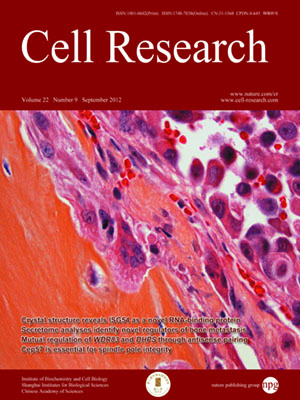
Volume 22, No 9, Sep 2012
ISSN: 1001-0602
EISSN: 1748-7838 2018
impact factor 17.848*
(Clarivate Analytics, 2019)
Volume 22 Issue 9, September 2012: 1339-1355
ORIGINAL ARTICLES
Global secretome analysis identifies novel mediators of bone metastasis
Mario Andres Blanco1, Gary LeRoy1, Zia Khan2,3,5, Maša Alečković1, Barry M Zee1, Benjamin A Garcia1 and Yibin Kang1,4
1Department of Molecular Biology, Princeton University, Princeton, NJ 08544, USA
2Department of Computer Science, Princeton University, Princeton, NJ 08540, USA
3Lewis Sigler Institute for Integrative Genomics, Princeton University, Princeton, NJ 08544, USA
4Genomic Instability and Tumor Progression Program, Cancer Institute of New Jersey, New Brunswick, NJ 08903, USA
5Current address: Department of Human Genetics, University of Chicago, Chicago, IL 60637, USA
Correspondence: Yibin Kang,(ykang@princeton.edu)
Bone is the one of the most common sites of distant metastasis of solid tumors. Secreted proteins are known to influence pathological interactions between metastatic cancer cells and the bone stroma. To comprehensively profile secreted proteins associated with bone metastasis, we used quantitative and non-quantitative mass spectrometry to globally analyze the secretomes of nine cell lines of varying bone metastatic ability from multiple species and cancer types. By comparing the secretomes of parental cells and their bone metastatic derivatives, we identified the secreted proteins that were uniquely associated with bone metastasis in these cell lines. We then incorporated bioinformatic analyses of large clinical metastasis datasets to obtain a list of candidate novel bone metastasis proteins of several functional classes that were strongly associated with both clinical and experimental bone metastasis. Functional validation of selected proteins indicated that in vivo bone metastasis can be promoted by high expression of (1) the salivary cystatins CST1, CST2, and CST4; (2) the plasminogen activators PLAT and PLAU; or (3) the collagen functionality proteins PLOD2 and COL6A1. Overall, our study has uncovered several new secreted mediators of bone metastasis and therefore demonstrated that secretome analysis is a powerful method for identification of novel biomarkers and candidate therapeutic targets.
Cell Research (2012) 22:1339-1355. doi:10.1038/cr.2012.89; published online 12 June 2012
FULL TEXT | PDF
Browse 2245


